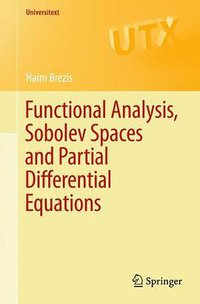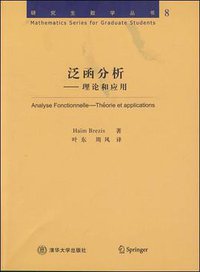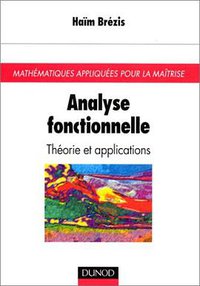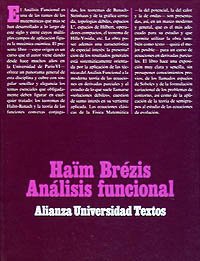泛函分析、索伯列夫空间和偏微分方程
豆瓣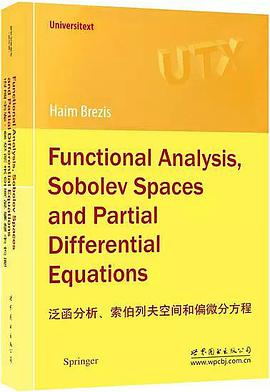
Functional Analysis, Sobolev Spaces and Partial Differential Equations
Haim Brezis
简介
该书提出了一个连贯的、确切的、统一的方法将两个来自不同领域的元素——泛函分析和偏微分方程,结合在一起,旨在为具有良好实分析背景的学生提供帮助。 通过详细地分析一维PDEs的简单案例,即ODEs,一个对初学者来说比较简单的方法,该书展示了从泛函分析到偏微分方程的平滑过渡。尽管已经有很多关于泛函分析和偏微分方程的书,该书却是第一本将二者紧密地结合在一起的书。此外,书中给出的例题和附加的材料,只因读者向前沿研究迈进。
该书的第一部分解泛函分析和算子理论中的抽象结果。第二部分主要研究具有特定可导性的函数空间,例如著名的索伯列夫空间,它是现代 PDEs理论的核心。索伯列夫空间在数学中随处可见,无论是纯数学还是应用数学, 以及微分几何、谐波分析、工程学、机械学、物理学等学科中的线形还是非线性偏微分方程,且它已经成为理工科专业研究生的工具书中不可或缺的内容。
读者对象:理工科专业的研究生、科研工作者以及工程师等。
contents
Preface
The Hahn-Banach Theorems. Introduction to the Theory of
Conjugate Convex Functions
1.1 The Analytic Form of the Hahn-Banach Theorem: Extension of
Linear Functionals
1.2 The Geometric Forms of the Hahn-Banach Theorem: Separation
of Convex Sets
1.3 The Bidual E. Orthogonality Relations
1.4 A Quick Introduction to the Theory of Conjugate Convex Functions
Comments on Chapter 1
Exercises for Chapter 1
2 The Uniform Boundedness Principle and the Closed Graph Theorem
2.1 The Baire Category Theorem
2.2 The Uniform Boundedness Principle
2.3 The Open Mapping Theorem and the Closed Graph Theorem
2.4 Complementary Subspaces. Right and Left inve.rtibility of Linear
Operators
2.5 Orthogonality Revisited
2.6 An Introduction to Unbounded Linear Operators. Definition of the
Adjoint
2.7 A Characterization of Operators with Closed Range.
A Characterization of Surjective Operators
Comments on Chapter 2
Exercises for Chapter 2
Weak Topologies. Reflexive Spaces. Separable Spaces. Uniform
Convexity
3.1 The Coarsest Topology for Which a Collection of Maps Becomes
Continuous
3.2 Definition and Elementary Properties of the Weak Topology
a(E, E*)
3.3 Weak Topology, Convex Sets, and Linear Operators
3.4- The Weak* Topology tr (E’’, E)
3.5 Reflexive Spaces
3.6 Separable Spaces
3.7 Uniformly Convex Spaces
Comments on Chapter 3
Exercises for Chapter 3
4 Lp Spaces
4.1 Some Results about Integration That Everyone Must Know
4.2 Definition and Elementary Properties of Lp Spaces
4.3 Reflexivity. Separability. Dual of Lp
4.4 Convolution and regularization
4.5 Criterion for Strong Compactness in Lp
Comments on Chapter 4
Exercises for Chapter 4
5 Hilbert Spaces
5.1 Definitions and Elementary Properties. Projection onto a Closed
Convex Set
5.2 The Dual Space of a Hilbert Space
5.3 The Theorems of Stampacchia and Lax-Milgram
5.4 Hilbert Sums. Orthonormal Bases
Comments on Chapter 5
Exercises for Chapter 5
Compact Operators. Spectral Decomposition of Self-Adjoint
Compact Operators
6.1 Definitions. Elementary Properties. Adjoint
6.2 The Riesz-Fredholm Theory
6.3 The Spectrum of a Compact Operator
6.4 Spectral Decomposition of Self-Adjoint Compact Operators
Comments on Chapter 6
Exercises for Chapter 6
The Hille--Yosida Theorem
7.1 Definition and Elementary Properties of Maximal Monotone
Operators
7.2 Solution of the Evolution Problem du
”37 + Au = 0 on [0, +cx),
u(0) = u0. Existence and uniqueness
7.3 Regularity
7.4 The Self-Adjoint Case
Comments on Chapter 7
8 Sobolev Spaces and the Variational Formulation of Boundary Value
Problems in One Dimension
8.1 Motivation
8.2 The Sobolev Space Wl’’P(l)
8.3 The Space W ’’p
8.4 Some Examples of Boundary Value Problems
8.5 The Maximum Principle
8.6 Eigenfunctions and Spectral Decomposition
Comments on Chapter 8
Exercises for Chapter 8
9 Sobolev Spaces and the Variational Formulation of Elliptic
Boundary Value Problems in N Dimensions
9.1 Definition and Elementary Properties of the Sobolev Spaces
WI,P()
9.2 Extension Operators
9.3 Sobolev Inequalities
9.4 The Space W’’P(f2)
9.5 Variational Formulation of Some Boundary Value Problems
9.6 Regularity of Weak Solutions
9.7 The Maximum Principle
9.8 Eigenfunctions and Spectral Decomposition
Comments on Chapter 9 .
10 Evolution Problems: The Heat Equation and the Wave Equation ..
I0.1 The Heat Equation: Existence, Uniqueness, and Regularity
10.2 The Maximum Principle
10.3 The Wave Equation
Comments on Chapter 10
11 Miscellaneous Complements
11.1 Finite-Dimensional and Finite-Codimensional Spaces
11.2 Quotient Spaces
11.3 Some Classical Spaces of Sequences
11.4 Banach Spaces over C: What Is Similar and What Is Different?..
Solutions of Some Exercises
Problems
Partial Solutions of the Problems
Notation
References
Index
